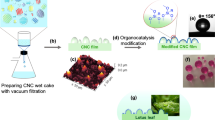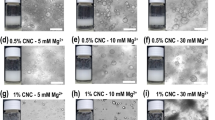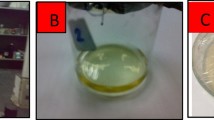Abstract
Dicarboxylate nanocrystalline cellulose (DCNC) polyelectrolytes were prepared from nanocrystalline cellulose (NCC) by introducing carboxylate units at the C-2 and C-3 positions of a glucose moiety through a two-step selective oxidation process. The polyelectrolyte nature of the DCNC was investigated by measuring the water uptake capacity with a customized ion exchange system. The equilibrium water uptake capacity of DCNC was almost ten times greater than that of conventional C-6 functionalized monocarboxylated NCC. The conversion of NCC to DCNC ensured the presence of a large number of dissociable electrolytic ions and high degrees of conformational freedom in the material to generate high osmotic pressure. Conductivity and dynamic light-scattering measurements were performed to relate the water uptake capacity with the chemical and structural changes of the polyelectrolytes. Furthermore, it was observed that the ionic strength of the solution played a critical role in controlling the water uptake capacity of the material.
This is a preview of subscription content, access via your institution
Access options
Subscribe to this journal
Receive 12 print issues and online access
$259.00 per year
only $21.58 per issue
Buy this article
- Purchase on Springer Link
- Instant access to full article PDF
Prices may be subject to local taxes which are calculated during checkout







Similar content being viewed by others
References
Song R, Murphy M, Li C, Ting K, Soo C, Zheng Z. Current development of biodegradable polymeric materials for biomedical applications. Drug Des Devel Ther 2018;12:3117–45.
Buchholz FL. Superabsorbent polymers: an idea whose time has come. J Chem Educ. 1996;73:512.
Martau GA, Mihai M, Vodnar DC. The use of chitosan, alginate, and pectin in the biomedical and food sector-biocompatibility, bioadhesiveness, and biodegradability. Polym (Basel). 2019;11:11
Shuster WW, Wang LK. Role of polyelectrolytes in the filtration of colloidal particles from water and wastewater. Sep Purif Rev. 1977;6:153–87.
Tripathi BP, Dubey NC, Stamm M. Functional polyelectrolyte multilayer membranes for water purification applications. J Hazard Mater 2013;252–253:401–12.
Zhao J. et al. Preparation of the polyelectrolyte complex hydrogel of biopolymers via a semi-dissolution acidification sol-gel transition method and its application in solid-state supercapacitors. J Power Sources. 2018;378:603–9.
Meka VS, Sing MKG, Pichika MR, Nali SR, Kolapalli VRM, Kesharwani P. A comprehensive review on polyelectrolyte complexes. Drug Discov Today. 2017;22:1697–706.
Nair LS, Laurencin CT. Biodegradable polymers as biomaterials. Prog Polym Sci. 2007;32:762–98.
Rinaudo M. Polyelectrolytes derived from natural polysaccharides. Monomers Polym Compos Renew Resour. 2008;495–516. https://doi.org/10.1016/B978-0-08-045316-3.00024-7.
Habibi Y. Key advances in the chemical modification of nanocelluloses. Chem Soc Rev. 2014;43:1519–42.
Li YY, Wang B, Ma MG, Wang B. Review of recent development on preparation, properties, and applications of cellulose-based functional materials. Int J Polym Sci. 2018. https://doi.org/10.1155/2018/8973643.
Iwamoto S, Kai W, Isogai A, Iwata T. Elastic modulus of single cellulose microfibrils from tunicate measured by atomic force microscopy. Biomacromolecules. 2009;10:2571–76.
Habibi Y, Foulon L, Aguié-Béghin V, Molinari M, Douillard R. Langmuir-Blodgett films of cellulose nanocrystals: preparation and characterization. J Colloid Interface Sci. 2007;316:388–97.
Shojaeiarani J, Bajwa D, Shirzadifar A. A review on cellulose nanocrystals as promising biocompounds for the synthesis of nanocomposite hydrogels. Carbohydr Polym. 2019;216:247–59.
Hashem M, Hauser P, Smith B. Reaction efficiency for cellulose cationization using 3-chloro-2- hydroxypropyl trimethyl ammonium chloride. Text Res J. 2003;73:1017–23.
Hemraz UD, Campbell KA, Burdick JS, Ckless K, Boluk Y, Sunasee R. Cationic poly(2-aminoethylmethacrylate) and polyN-(2-aminoethylmethacrylamide) modified cellulose nanocrystals: Synthesis, characterization, and cytotoxicity. Biomacromolecules. 2015;16:319–25.
Feese E, Sadeghifar H, Gracz HS, Argyropoulos DS, Ghiladi RA. Photobactericidal porphyrin-cellulose nanocrystals: synthesis, characterization, and antimicrobial properties. Biomacromolecules. 2011;12:3528–39.
Vasconcelos NF. et al. Chemically modified cellulose nanocrystals as polyanion for preparation of polyelectrolyte complex. Cellulose. 2019;26:1725–46.
Wang Y, Wang X, Xie Y, Zhang K. Functional nanomaterials through esterification of cellulose: a review of chemistry and application. Cellulose. 2018;25:3703–31.
Zaman M, Xiao H, Chibante F, Ni Y. Synthesis and characterization of cationically modified nanocrystalline cellulose. Carbohydr Polym. 2012;89:163–70.
Moral A, Aguado R, Ballesteros M, Tijero A. Cationization of alpha-cellulose to develop new sustainable products. Int J Polym Sci. 2015;2015. https://doi.org/10.1155/2015/283963.
Sharma A, Thakur M, Bhattacharya M, Mandal T, Goswami S. Commercial application of cellulose nano-composites—a review. Biotechnol Rep. 2019;21:e00316
Ono T, Sugimoto T, Shinkai S, Sada K. Lipophilic polyelectrolyte gels as super-absorbent polymers for nonpolar organic solvents. Nat Mater. 2007;6:429–33.
de Nooy AEJ, Besemer AC, van Bekkum H. Highly selective tempo mediated oxidation of primary alcohol groups in polysaccharides. Recl des Trav Chim des Pays‐Bas. 1994;113:165–6.
Isogai A. Wood nanocelluloses: fundamentals and applications as new bio-based nanomaterials. J Wood Sci. 2013;59:449–59.
Liimatainen H, Visanko M, Sirviö JA, Hormi OEO, Niinimaki J. Enhancement of the nanofibrillation of wood cellulose through sequential periodate-chlorite oxidation. Biomacromolecules. 2012;13:1592–7.
Casu B. et al. Communications from research groups: Structure and conformation of polyalcohols and polyacids obtained from periodate oxyamylose and oxycellulose. Carbohydr Polym. 1982;2:283–7.
Bondeson D, Mathew A, Oksman K. Optimization of the isolation of nanocrystals from microcrystalline cellulose by acid hydrolysis. Cellulose. 2006;13:171–80.
Veelaert S, de Wit D, Gotlieb KF, Verhé R. Chemical and physical transitions of periodate oxidized potato starch in water. Carbohydr Polym. 1997;33:153–62.
Saito T, Kimura S, Nishiyama Y, Isogai A. Cellulose nanofibers prepared by TEMPO-mediated oxidation of native cellulose. Biomacromolecules. 2007;8:2485–91.
Habibi Y, Chanzy H, Vignon MR. TEMPO-mediated surface oxidation of cellulose whiskers. Cellulose. 2006;13:679–87.
Zhang K, Feng W, Jin C. Protocol efficiently measuring the swelling rate of hydrogels. MethodsX. 2020;7:100779.
Pourjavadi A, Hosseinzadeh H, Mazidi R. Modified carrageenan. 4. Synthesis and swelling behavior of crosslinked ΚC-g-AMPS superabsorbent hydrogel with antisalt and pH-responsiveness properties. J Appl Polym Sci. 2005;98:255–63.
Xiang Q, Lee YY, Pettersson PO, Torget RW. Heterogeneous aspects of acid hydrolysis of α-cellulose. Appl Biochem Biotechnol. 2003;107:505–14.
Fang Y, Takahashi R, Nishinari K. Protein/polysaccharide cogel formation based on gelatin and chemically modified schizophyllan. Biomacromolecules. 2005;6:3202–8.
Hofreiter BT, Wolff IA, Mehltretter CL. Chlorous acid oxidation of periodate oxidized cornstarch. J Am Chem Soc. 1957;79:6457–60.
Plappert SF. et al. Transparent, flexible, and strong 2,3-dialdehyde cellulose films with high oxygen barrier properties. Biomacromolecules. 2018;19:2969–78.
Osório VM, Cardeal ZL. Analytical methods to assess carbonyl compounds in foods and beverages. J Braz Chem Soc. 2013;24:1711–8.
Floor M. et al. Structural and conformational effects on the complexation of calcium by 2,3-dicarboxy derivatives of β-cyclodextrin (cyclomaltoheptaose), amylose, and cellulose. Carbohydr Res. 1990;203:19–32.
Hossain MA, Roy CK, Sarkar SD, Roy H, Howlader AH, Firoz SH. Improvement of strength of poly(acrylic acid) hydrogels by the incorporation of functionally modified nanocrystalline cellulose. Mater Adv. 2020;1:639–47.
Chavan VB, Sarwade BD, Varma AJ. Morphology of cellulose and oxidised cellulose in powder form. Carbohydr Polym. 2002;50:41–5.
Akhlaghi SP, Berry RC, Tam KC. Surface modification of cellulose nanocrystal with chitosan oligosaccharide for drug delivery applications. Cellulose. 2013;20:1747–64.
Kargarzadeh H, Ahmad I, Abdullah I, Dufresne A, Zainudin SY, Sheltami RM. Effects of hydrolysis conditions on the morphology, crystallinity, and thermal stability of cellulose nanocrystals extracted from kenaf bast fibers. Cellulose. 2012;19:855–66.
Julien S, Chornet E, Overend RP. Influence of acid pretreatment (H2SO4, HCl, HNO3) on reaction selectivity in the vacuum pyrolysis of cellulose. J Anal Appl Pyrolysis. 1993;27:25–43.
Vicini S. et al. Thermal analysis and characterisation of cellulose oxidised with sodium methaperiodate. Thermochim Acta. 2004;418:123–30.
Dan S, Banivaheb S, Hashemipour H, kalantari M. Synthesis, characterization and absorption study of chitosan-g-poly(acrylamide-co-itaconic acid) hydrogel Polym. Bull. 2020;78:1887–907.
Abdel-Raouf ME, El-Saeed SM, Zaki EG, Al-Sabagh AM. Green chemistry approach for preparation of hydrogels for agriculture applications through modification of natural polymers and investigating their swelling properties. Egypt J Pet. 2018;27:1345–55.
Harries D, May S, Ben-Shaul A. Counterion release in membrane–biopolymer interactions. Soft Matter. 2013;9:9268.
Zhou HX, Pang X. Electrostatic interactions in protein structure, folding, binding, and condensation. Chem Rev. 2018;118:1691–741.
Dobrynin AV, Rubinstein M. Theory of polyelectrolytes in solutions and at surfaces. Prog Polym Sci. 2005;30:1049–118.
Acknowledgements
The authors thankfully acknowledge the financial support from Bangladesh University of Engineering and Technology (BUET) and the Ministry of Science and Technology (Government of the People’s Republic of Bangladesh) for this research.
Author information
Authors and Affiliations
Corresponding author
Ethics declarations
Conflict of interest
The authors declare no competing interests.
Additional information
Publisher’s note Springer Nature remains neutral with regard to jurisdictional claims in published maps and institutional affiliations.
Rights and permissions
About this article
Cite this article
Motiur Rahman, M., Hasan Howlader, A., Rahman, E. et al. Development of functionalized nanocrystalline cellulose-based polyelectrolytes with high water uptake. Polym J 53, 913–921 (2021). https://doi.org/10.1038/s41428-021-00483-1
Received:
Revised:
Accepted:
Published:
Issue Date:
DOI: https://doi.org/10.1038/s41428-021-00483-1



